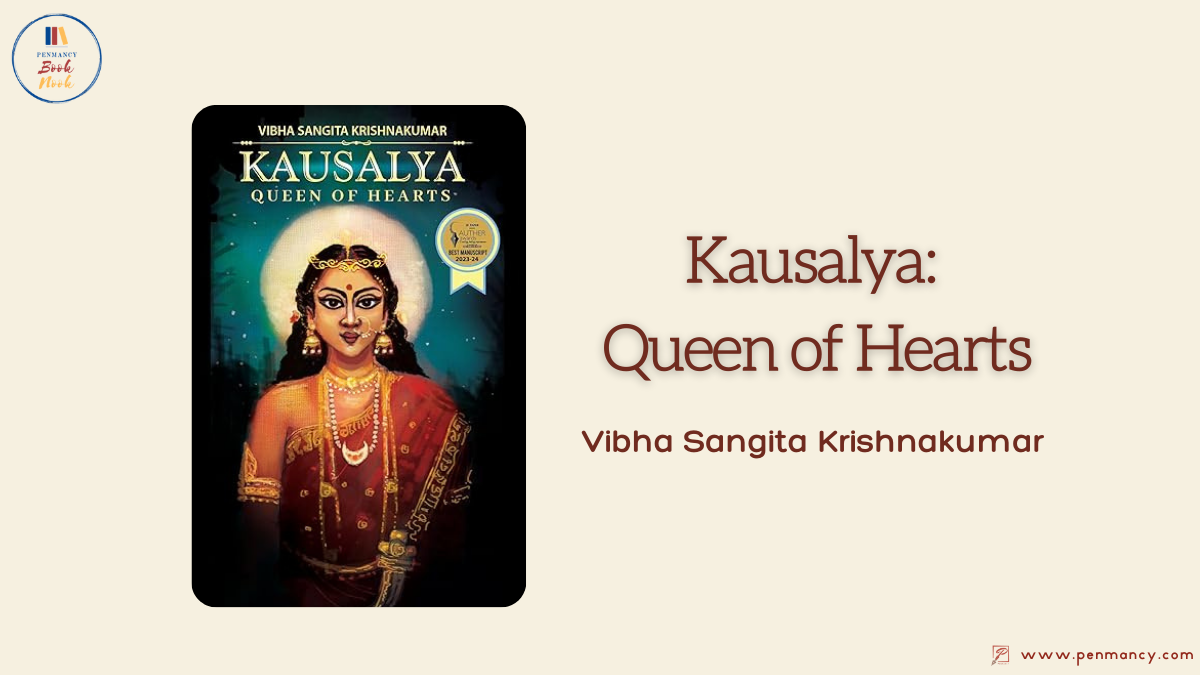
Kausalya, Queen of Hearts - Vibha Sangita Krishnakumar’s maiden foray into the world of novel writing, pleasantly surprised me by both its choice of subject, and the author’s rather unusual manner of handling it. Both the book cover and its blurb adequately convey the central theme of how a less known, barely talked about character in the Ramayana is made into a living, breathing, multi-layered protagonist. Queen Kausalya, who usually remains in the shadows of her righteous husband and legendary son in the epic, occupies centre stage in this novel, dwarfing all those around her.
As the feisty princess of Kosala and later, the Queen of Ayodhya, Kausalya has been portrayed as a dark-skinned beauty, blessed with a flair for both the performing arts as well as ruthless warfare. If she strums the tanpura with serenity and passion, she wields her razor-sharp dagger with equal ease and agility. She is unapologetically courageous and gritty who displays remarkable equanimity when thrust into the direst of circumstances. This makes her an asset to both her paternal and marital families. The novel hinges completely on Kausalya’s checkered journey through life, her marriage to King Nemi (Dasharath), her equation with the King’s later consorts, Kaikeyi and Sumitra, her role as a mother, her administrative acumen, her abiding love for all her dear ones, the many roadblocks strewn along her path and how she navigates them all with her signature dedication, grace, foresight and virtue.
The USP of the novel, for me, is the tone and language employed by the author – it is easy and conversational, bordering on the modern, thus making it an engaging, fast-paced read. If some of the GenZ expressions slightly startle the reader, the taut, crisp narration manages to hold his attention. In spite of the lofty, mythological subject there is no melodrama, exaggeration, or unwarranted protraction. Important milestones like Kausalya’s marriage, Shantha’s departure or even Rama-Sita’s wedding have been described very succinctly.
The author displays a vivid sense of imagination and recreation - the splendid palace of Ayodhya, its thoughtfully designed town, its holistic administrative practices, and the grand Parvati temple of Kosala are a few relevant examples. The scene where the new-born Rama is brought back from the throes of death is, indeed, goosebump-inducing! The mention of ‘mercy killing’ in those times took me by surprise.
Being the young, new-age author that she is, Vibha has peppered her novel with generous doses of feminist sensibilities that further accentuate the contemporary tone of her book. Almost every female character is courageous and outspoken; each one is acutely aware of her rights and doesn’t flinch before fighting for them. Not only Kausalya but Amritaprabha, Arundhati, Varshini, Kaikeyi, Sumitra, Shantha, Sita –all have been imbued with the same love for their individual identity and the urge to follow their heart and their passion. They all (including the three co-wives of Nemi) form a strong sisterly tribe marked by mutual acceptance, camaraderie, respect and support. Even the kings – Nemi, Sukaushal, Rompad and Rama - have been shown as practitioners of gender equality and emancipation. In fact, Nemi gives complete freedom to Kausalya to make her own choices and decisions, and even add a fresh look to the royal durbar and its proceedings. As a reader, I have wondered whether the dark-skinned, fiercely intrepid personality of Kausalya is a deliberate attempt to smash the age-old patriarchal association of fairness with beauty, and meekness with virtue.
Having said that, the novel contains a few issues which I personally found difficult to process. Ravana’s connection with Kausalya, Kaikeyi’s selfless love for Kausalya and Rama, Sumitra’s rash act, Sita’s mental health issues, the exile episode of Rama, Ravana being the father of Sita (and the non-kidnap), the great battle of Lanka and Sita’s rancour about it — too many crucial events re-imagined and retold in a hurry. Too many surprises sprung, without offering a proper rationale or back story, leaving the reader breathless, dazed, and groping in the dark. If Sita needed a cure for ill-health, why send them on a fourteen-year-long perilous ‘exile’? If Sita – or Bhoomija –willingly visited Lanka, her beloved birthplace, why did it mandate a devastating war? One, that left her fuming at her husband?
Mythological retelling is tricky ground and is always fraught with the danger of leaving behind a few loose ends. More so, when the author is this young and just starting off. Nevertheless, I laud Vibha for her courage and conviction, for her story-telling skills, and for shining the light on a hitherto undervalued character of the Ramayana. The book makes us analyse, deliberate, debate, and wonder, and for that, I certainly appreciate it.
***
[I received this book from Penmancy as a part of its Book Nook Programme.]
